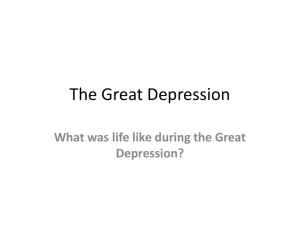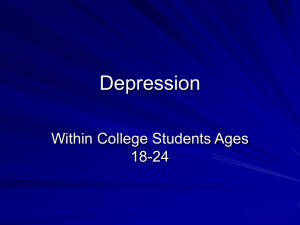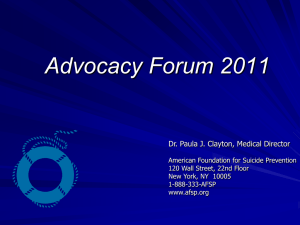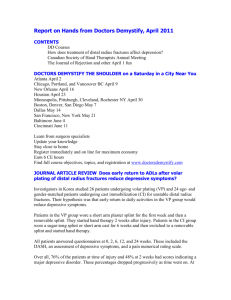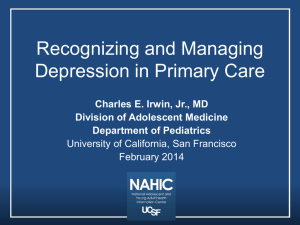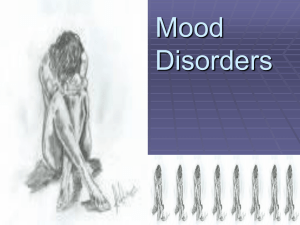Depression Screening - Purdue University Calumet
advertisement
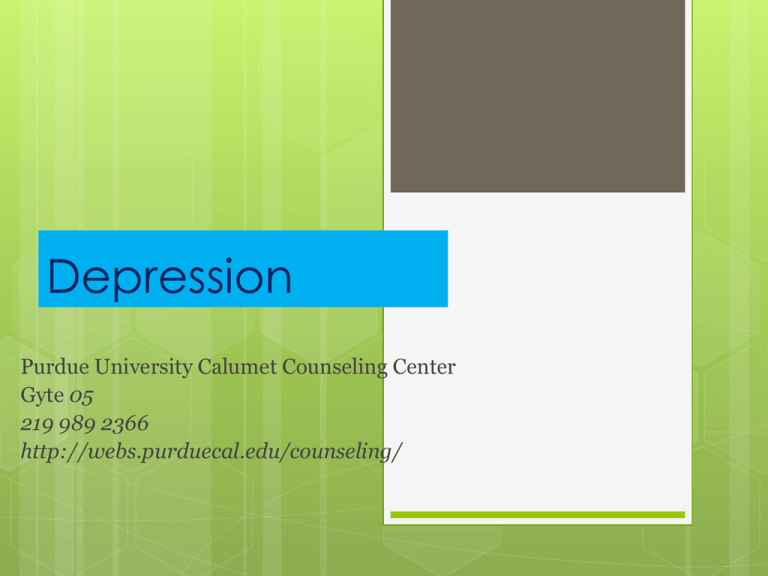
Depression Purdue University Calumet Counseling Center Gyte 05 219 989 2366 http://webs.purduecal.edu/counseling/ What are the symptoms? Depressed mood (feeling sad or empty) most of the day, nearly every day Loss of pleasure in activities once enjoyed Significant weight loss or weight gain (change of more than 5% body weight in a month) Insomnia (trouble sleeping) or hypersomnia (sleeping too much) Symptoms Psychomotor agitation (physical and emotional responses sped up) or retardation (physical and emotional responses slowed down) Fatigue or loss of energy Feeling worthless or excessive/inappropriate guilt Diminished ability to think or concentrate, or indecisiveness Recurrent thoughts of death, suicidal ideation, suicide attempts, or having a plan for suicide. Others may notice depression if you: Consistently making negative statements about themselves -Withdrawing from social involvement -Increasing in irritability or angry outbursts -Losing interest in sexual activity -Begin complaining of frequent headaches, stomachaches, or muscle pain Who does it affect? Over 50% of university students report feeling depressed at some point since their freshman year of college 15% of college students meet the criteria for clinical depression Women are twice as likely to experience depression as men (though this may be related to gender differences in the way sadness is expressed) Related Symptoms Anxiety Substance abuse Common Myths Depression is not a real medical problem. -Extensive research has indicated genuine biological and genetic factors that contribute to the development of depression, not just psychological factors. Depression can be changed by “positive thinking” if a person is strong enough. -Depression is not something people can “snap out of” with positive thinking, as research shows that it can change brain structure and alter thoughts and perceptions. Common Myths cont. Depression will go away on its own. -Without treatment, depression can last for months, years, or worse: it can result in suicide, the 3rd leading cause of death for Americans between 18-24. Depression only results from traumatic events, such as the death of a loved one. - Sometimes, painful events in life can bring about a depressive episode, but for many people it occurs when everything in life seems to be going smoothly. How can you know? Periods of sadness are normal throughout your life, so to help determine the difference: Depression Screening: http://www.depressionscreening.org/depression_screen.cfm Completely anonymous and confidential Does not provide a clinical diagnosis, but can give you some idea of whether you (or someone you care about) should seek professional help What makes depression worse? Ignoring the problem, denying the problem, or waiting for it to go away Alcohol Drugs Social isolation from friends and family Poor diet Poor sleeping habits/schedule What can you do? Accept that the problem exists Stay active Limit alcohol consumption Increase social activity Eat a balanced diet, and don’t skip meals Help is Available: Seek professional help. Contact PUC Counseling Center at 219 989 2366 or come to the office at Gyte 05 Contact PUC Student Health Service Center at 219 989 1235 or come to the office at Gyte Annex 34 References American Psychiatric Association (2000). Diagnostic and statistical manual of mental disorders (4th ed., Text Revision). Washington, DC: Author. Fava M, Cassano P. Mood disorders: Major depressive disorder and dysthymic disorder. In: Stern TA, Rosenbaum JF, Fava M, Biederman J, Rauch SL, eds. Massachusette General Hospital Comprehensive Clinical Psychiatry. 1st ed. Philadelphia, Pa: Mosby Elsevier; 2008:chap 29. Kessler, R. C., McGonagle, K. A., Zhao, S., Nelson, C. B., Hughes, M., Eshleman, S., Wittchen, H.U., & Kendler, K.S. (1994). Lifetime and 12-month prevalence of DSM-III-R psychiatric disorders in the United States. Results from the National Comorbidity Survey. Archives of General Psychiatry, 51, 8-19 References (con’t) Furr, Susan R.; Westefeld, John S.; McConnell, Gaye N.; Jenkins, J. Marshall (2001). Professional Psychology: Research and Practice, 32, 97-100. National Institute of Mental Health (NIMH) http://www.nimh.nih.gov/ Nolen-Hoeksema, S., Larson, J., & Grayson, C. (1999). Explaining the gender difference in depressive symptoms. Journal of Personality and Social Psychology, 77, 1061-1072






